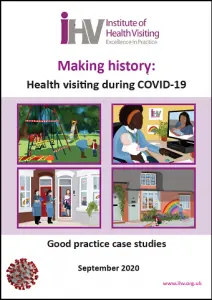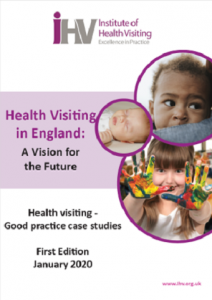The Institute of Health Visiting (iHV) has published “Making History: health visiting during COVID-19”, a collection of case studies which presents a window into the working lives of health visitors and families navigating the ups and downs of the COVID-19 pandemic.
In these unprecedented times, the world “locked down”. Yet life continued, babies kept being born and the normal struggles of parenthood became amplified for many.
Whilst some families enjoyed the relative peace of an enforced slower pace of life; most families were negatively impacted by lockdown and home was not a safe place for some, with rates of domestic violence and abuse, mental health problems and safeguarding concerns quickly becoming a source of concern.
The case studies, family stories and creative pieces contained within “Making History: Health visiting during COVID-19” capture the pace and scale of change as health visiting services adapted to working during “lockdown”.
Alison Morton, Director of Policy at the Institute of Health Visiting, commented:
“It has taken a global public health pandemic to shine a spotlight on the importance of the health visiting service.
“Parents reached out to health visitors for support as many other sources of support were no longer available. Health visitors are Specialist Community Public Health Nurses providing a vital “safety net” for babies, young children and their families whose needs can easily be hidden from sight. Their specialist public health skills, supporting babies, young children and their families during the biggest public health emergency in living memory, have been needed more than ever.”
Health visitors have risen to this challenge with professionalism and autonomy, flexing and developing innovative service “workarounds” to ensure that families receive the best possible support. Different areas have responded in different ways, many introducing “virtual contacts” instead of face-to-face, as well as rapidly responding to urgent needs to support families using Personal Protective Equipment.
Councillor Ian Hudspeth, Chairman of the Local Government Association Community Wellbeing Board, commented:
“Councils are incredibly proud of how their public health workforce has responded over the last 6 months. This report is testimony to the commitment and resilience of health visitors and illustrates the pivotal role they play in ensuring children and families get the support they need in challenging times.
“In the upcoming Spending Review, we are asking the Government to reverse the £700 million of public health reductions, to enable councils to strengthen this workforce and ensure we can continue to support families when they need us most.”
Alison Morton concluded:
“We need to learn from COVID-19 and the experiences of families and health visitors to ensure that the health visiting service is strengthened and fit to face the challenges that lie ahead as we adapt to living with the virus for the foreseeable future. The challenges that we face are not insurmountable – individually and collectively we have the ability to put things right. But this requires bold action to make the difference – there is no time to waste, the time to act is now.”
Our recommendations for restoration of the health visiting service are:
- Health visiting services should be reinstated (where they have not been) as a matter of urgency as a vital support and safety-net for children, with appropriate measures put in place, including the use of PPE, to reduce the spread of the virus.
- Health visiting services must be fully prepared for any future waves of COVID-19. NHS England should revise the Community Prioritisation Plan (for phase one pandemic management) and develop clear messages on the importance of continuation of the service to ensure the needs of children are prioritised. This should include removing wording on the redeployment of health visitors.
- A clear workforce plan is needed to ensure that the service has sufficient surge capacity to manage the backlog of missed appointments, as well as demand for support due to the secondary impacts of the pandemic.
- An evaluation of the use of virtual, non-face-to-face service delivery methods is urgently needed to determine their effectiveness for identification of vulnerabilities and risks, impact on child and family outcomes and reducing inequalities to inform future digital change.
- A cross-government strategy is needed to reduce inequalities and “level-up” our society – this will require investment to strengthen the health visiting service which plays a crucial role in the early identification and support of the most disadvantaged families.
- The impact of working during the COVID-19 pandemic on staff wellbeing cannot be underestimated – a proactive plan is needed to ensure staff have the right support during the restoration of services and to create high quality workplaces for all staff in the future




